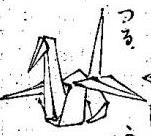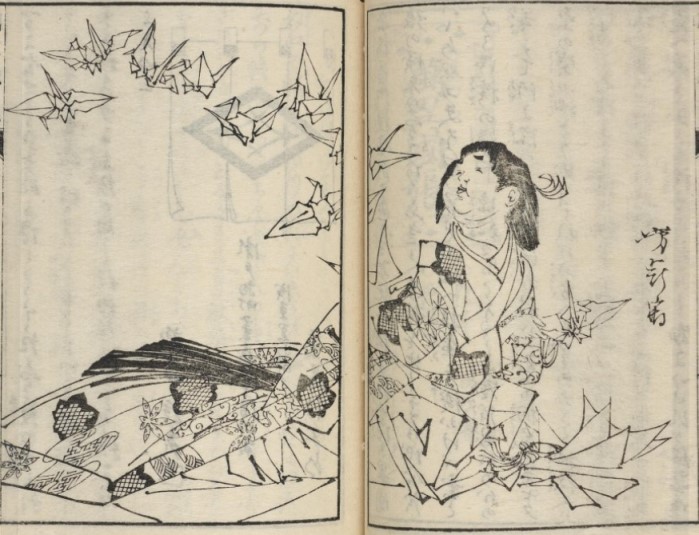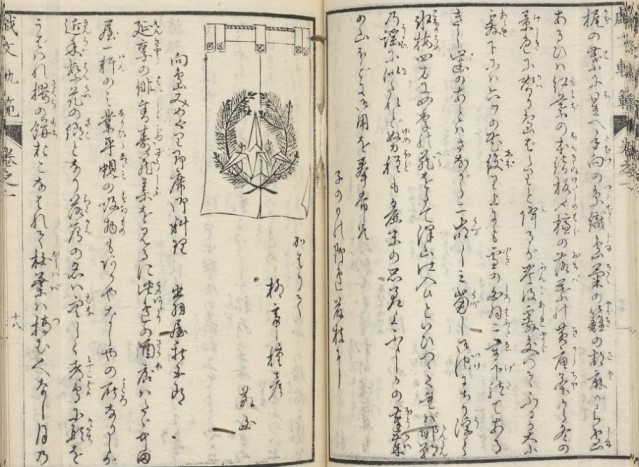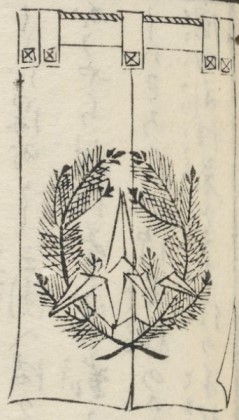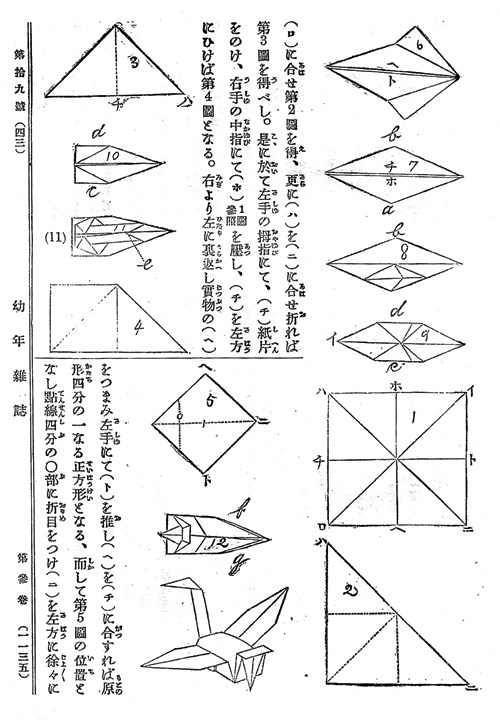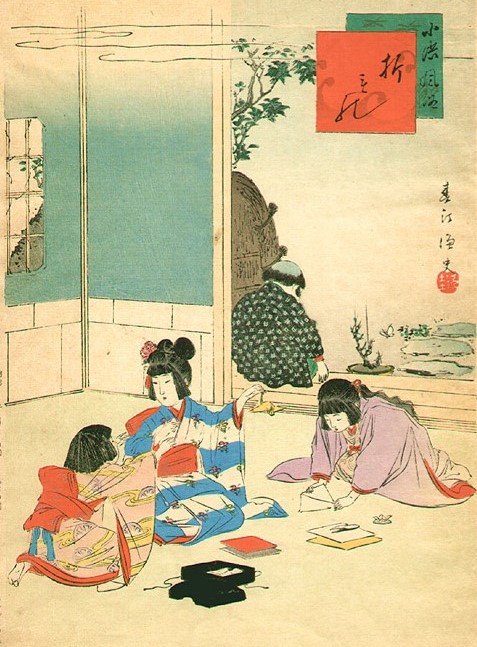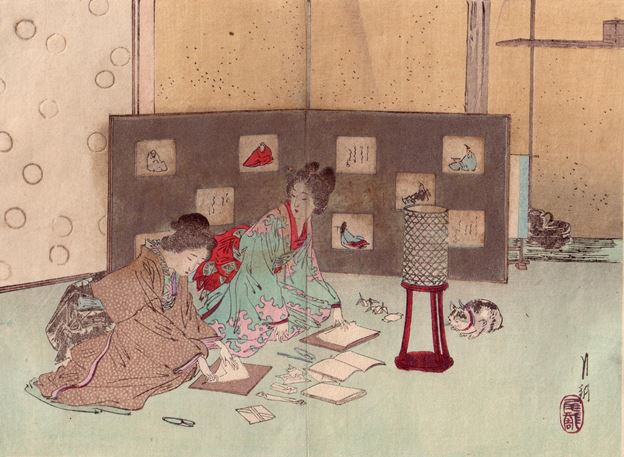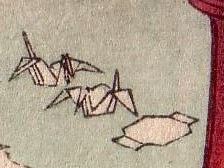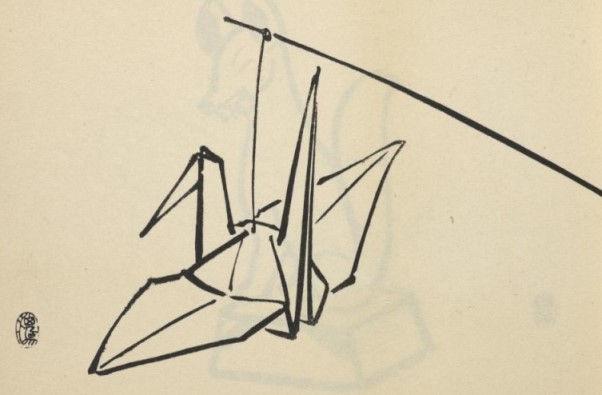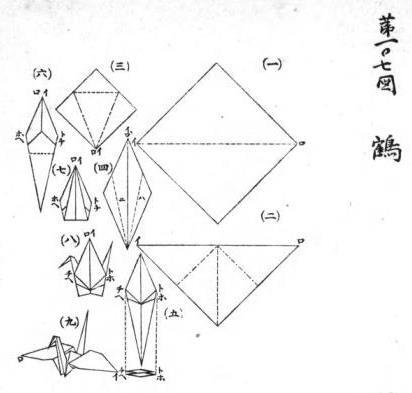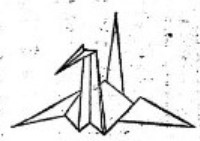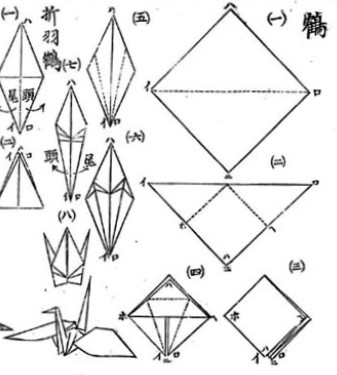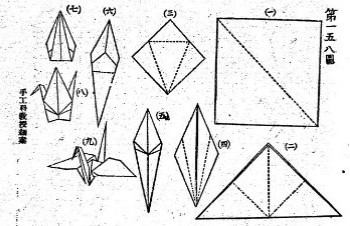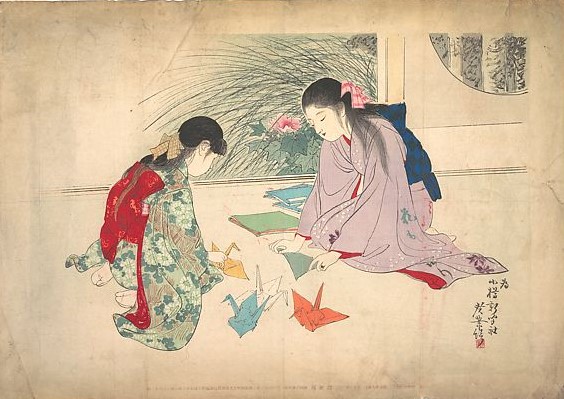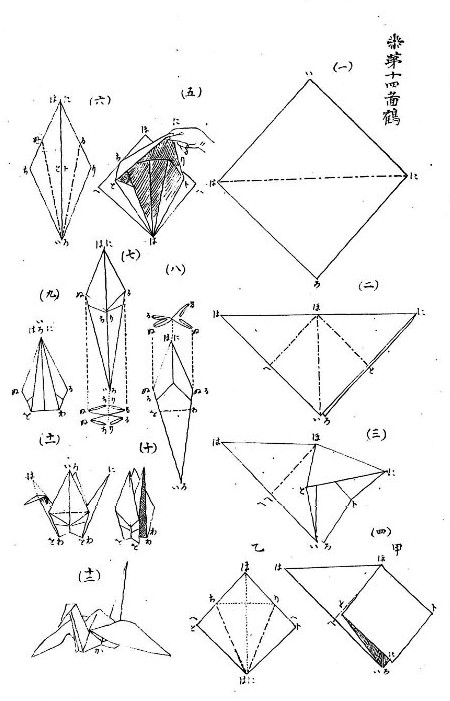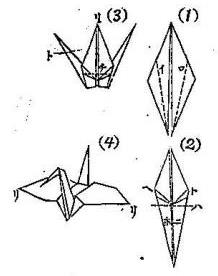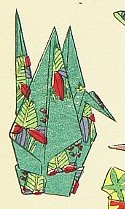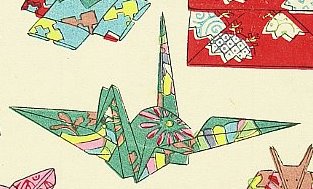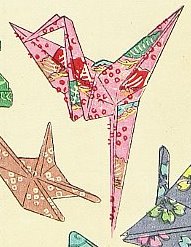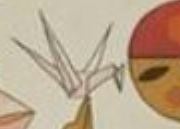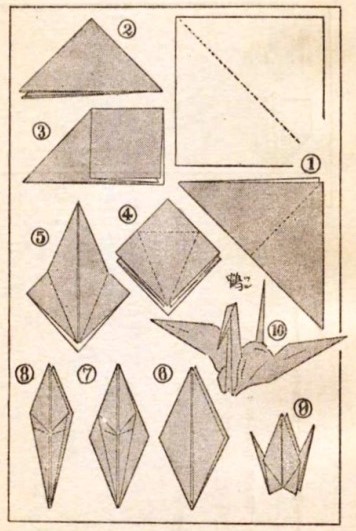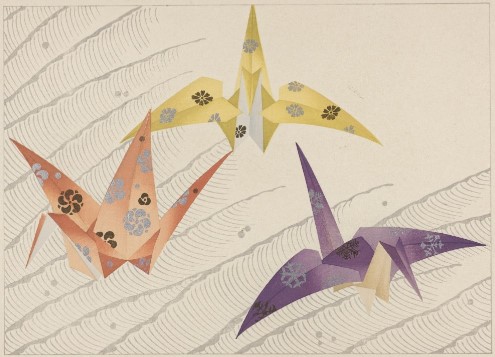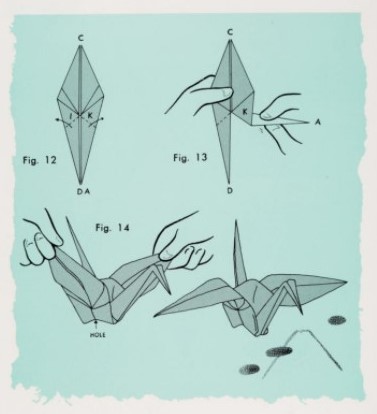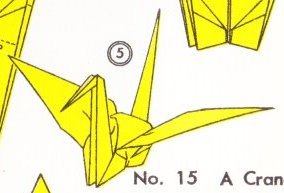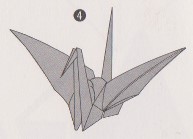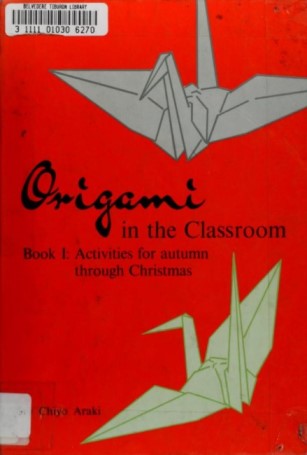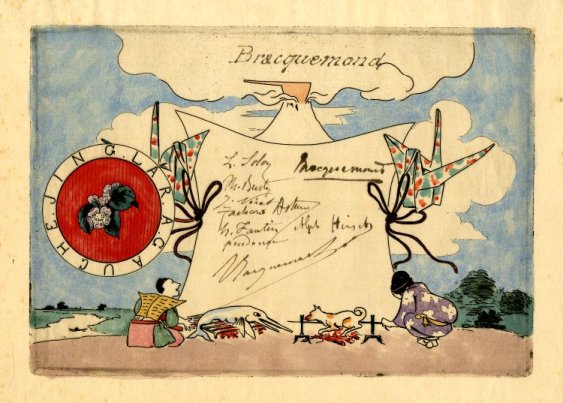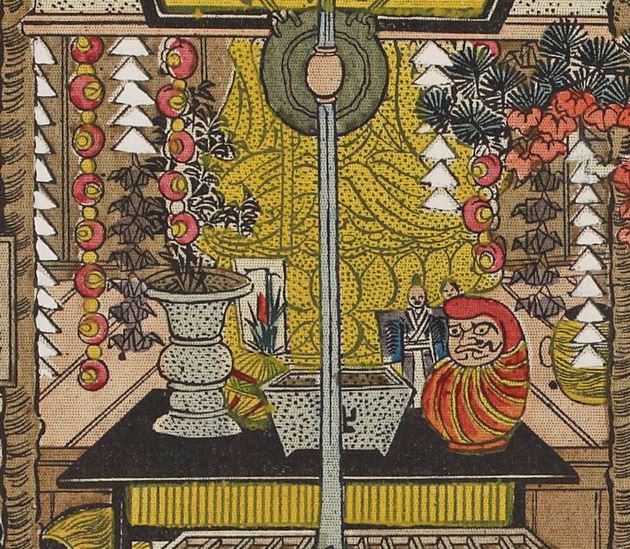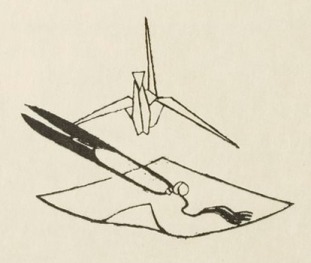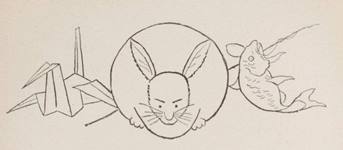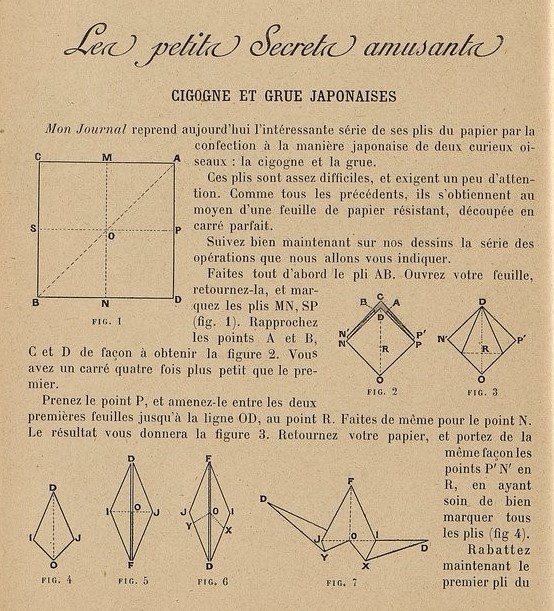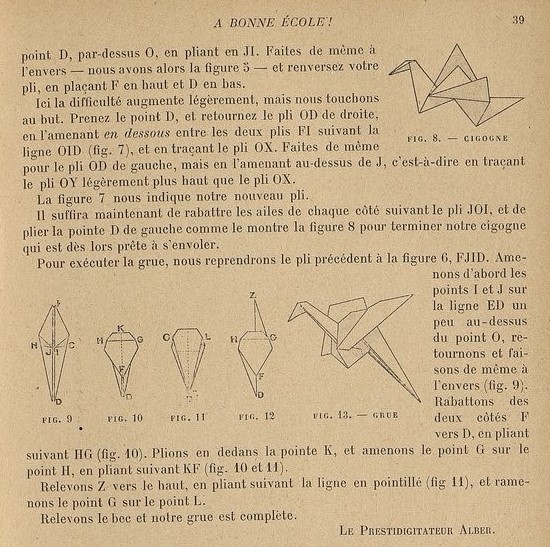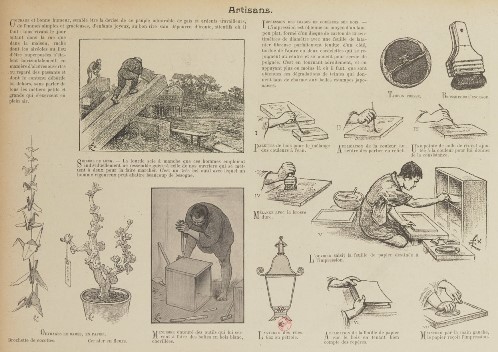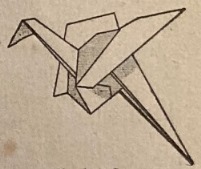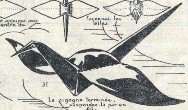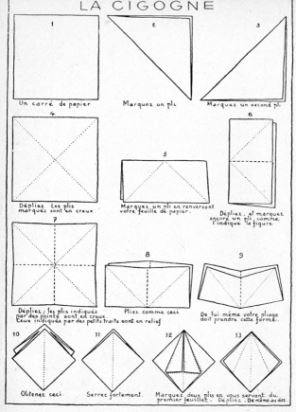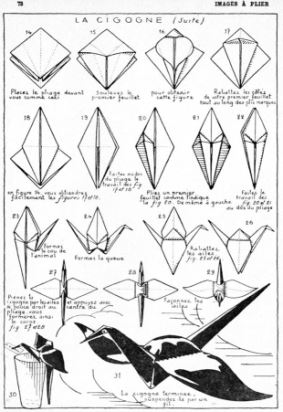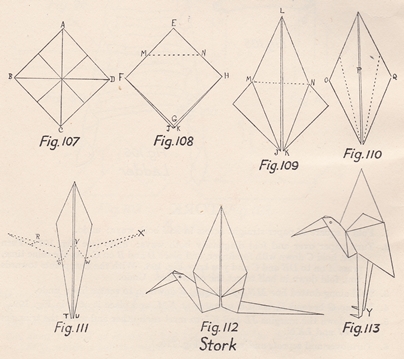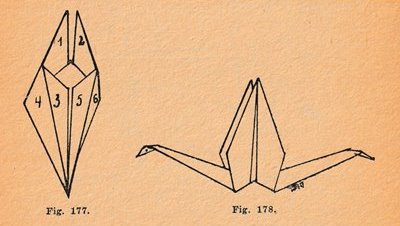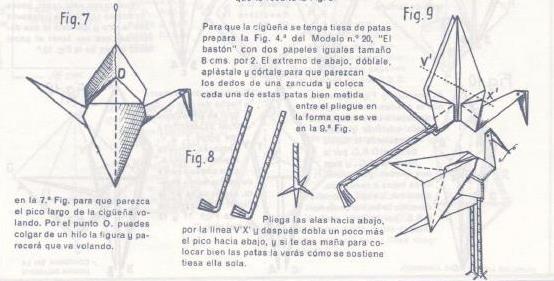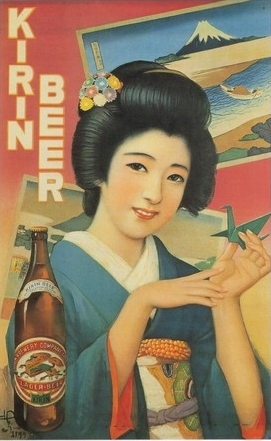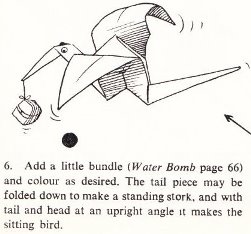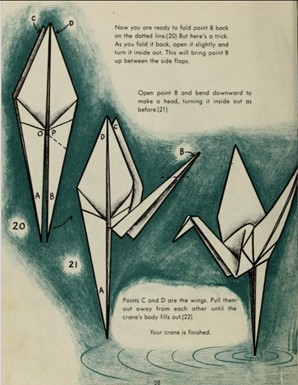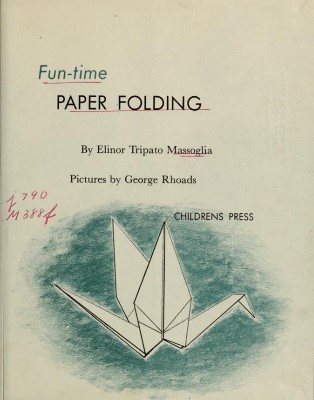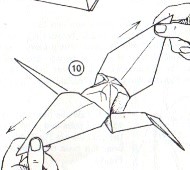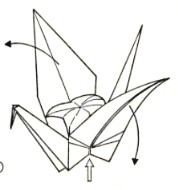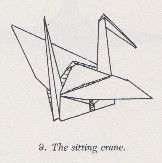| The Public Paperfolding History Project
Last updated 16/12/2025 x |
|||||||
| The Paper Crane / Tsuru / Orizuru | |||||||
This page is being used to collext information about the history of the traditional Japanese design known as the Tsuru / Orizuru / Crane / Paper Crane. Please contact me if you know any of this information is incorrect or if you have any other important information that should be added. Thank you. There is a separate page about the history of Connected Cranes and another about the history of Strings of Cranes. There is also a page about Sadako Sasaki. In 18th and 19th Century Japan, and quite possibly in earlier times, the Paper Crane was seen as an inflatable design, air being blown in through the hole in the bottom of the body. ********** The earliest evidence for the existence of The Paper Crane is from 1591/3 (see below). There are two ways to account for the existence of such an accomplished representational paperfold at such an early date. The first possible theory is that the Paper Crane is not a one-off but that it is the sole survivor of a lost paperfolding culture which would also have included many other representational designs made in similar ways. This is an attractive idea, but the problem in believing it is that there is no evidence for the existence of any other similar designs at an early enough date. Surely some other design apart from the Paper Crane would have survived alongside it? The second possible theory is that the Paper Crane was a one-off design that was discovered by accident rather than created by design. A version of this theory was advanced by Isao Honda in his book 'The World of Origami':
However, the idea that the accident happened 'during an attempt to develop something else' seems to take us straight back to theory one and I thus prefer the idea that the discovery might have happened entirely at random while some unknown ancient paperfolder was playing around with a square of paper. My version of the second theory has the merit that it does not necessitate imagining a whole lost culture of representational paperfolding design, but, of course, it is by its very nature unprovable. It is worth noting, however, that the idea of developing multiple designs from bases does not otherwise appear until the publication of the 'Orikata Tehon Chushingura' in 1797, and, even then, it is not the bird base that is used. ********** In China (and in publications by Chinese authors) 1914 Diagrams for the Paper Crane appear in 'Zhe zhi tu shuo' (Illustrated Paperfolding), compiled by Gui Shaolie, which was published by the Commercial Press in Shanghai in Ming guo 3 (1914).
********** In Japan (and in publications by Japanese authors) 1591/3 According to an article in the Asahi Shimbun Digital of February 22nd 2017, the oldest known representations of the Orizuru have been found on a kozuka which can be dated to around 1600. Masatsugu Tsutsumi has since informed me that this has been narrowed down to 1591/3. I have not seen any other evidence to support the dating of this artifact.
********** 1700 This design for a kosode featuring Paper Cranes was published in 1700 in the pattern book 'Tokiwa Hinagata' by Koheiji Terada and Shotaro Morida.
********** 1704 Another design for a kosode featuring Paper Cranes appears in 'Tanzen Hinagata' which was published in 1704.
********** 1716 This design featuring Paper Cranes comes from the pattern book (Chinshoku) 'Hinagata miyako fuzoku' (Rare and Popular Kimono Patterns of the Capital) by Nishikawa Sukenobu, which was published in 1716.
********** 1717 These details from prints in the picture book 'Keisei Ori Tsuru', by an unknown author, published in 1717, all show Paper Cranes. In the top picture a child studying in a terakoya (a school for the children of commoners) is writing a poem on the wing of one Paper Crane. In the middle picture three figures look upwards at another Paper Crane flying above their heads. In the lower picture a woman rides on a large Paper Crane.
********** c1720 In this shunga print by Nishikawa Sukenobu, sometimes titled 'Silently', the woman to the left is wearing a garment decorated with Paper Cranes.
********** 1730 Paper Cranes also appear in 'Hinagata Amanohishidate' by Nakajima Tanjiro, which was published in 1730.
********** 1731 These three images are details from prints in Nishikawa Sukenobu's illustrated book 'Ehon tokiwagusa', published in 1931. All show women / children wearing garments decorated with Paper Cranes.
********** 1732 In this print, which comes from 'Onna fuhzoku tama kagami' by Nishikawa Sukenobu and which was published in 1732. one of the women is holding a Paper Crane and blowing into it to inflate the body.
********** 1734 Paper Cranes are also among the designs illustrated in a woodcut from a Japanese book called 'Ranma Zushiki' published in 1734.
********** 1735 In this print from 'Nishikawa fudenoumi' by Nishikawa Sukenobu, said to date from 1735, the woman at the back is holding a Paper Crane by its tail.
********** 1742 This image is a detail from a print in Nishikawa Sukenobu's illustrated book 'Jokyo bunsho kagami', volume 1, which was published in 1742. It also shows a woman wearing a garment decorated with Paper Cranes.
********** 1748 'Ehon masukagami' by Nishikawa Sukenobu, which was published in 1748, contains a print showing the Hina Doll Festival in which one of the women is holding up a Paper Crane.
********** This image showing a kimono patterned with Paper Cranes is a detail from another print in the same book.
********** 1752 A drawing of the Paper Crane appears in a print by Nishikawa Suketada which is found in his 'Ehon hana no utage' published in 1752.
********** 1770 This print by Ippitsusai Buncho, which shows a samurai wearing a kimono patterned with Paper Cranes, is from Volume 2 of the picture book 'Ehon butai ogi' which was published in 1770.
********** This print by Suzuki Harunobu (1724 -1770), which shows a woman folding a crane with two previously completed ones on the floor, is from Volume 1 of the picture book 'Ehon seiro bijin awase' which was published in 1770.
*** This print, from Volume 3 of the same work, shows a woman wearing a Paper Crane patterned outer robe.
********** 1765 - 1770 These four prints by Suzuki Harunobu (1725-1770) show kimonos decorated with paper cranes. (Information from Juan Gimeno) The full-colour technique used to make these prints was first used in 1765 and these prints must therefore date to between then and his death in 1770.
***
***
***
Note, however, that according to Origami in Ukiyo-e prints this print is 'Parody of the Story of the Chrysanthemum' by Mitate Kiku Jido, 1765. ********** 1772/3 This print entitled 'Orizuru o tsukuru shojo' (Children folding a paper crane) by Koryusai Isoda (active 1764 -1788) is in the collection of the Library of Congress in Washington, USA. According to https://www.loc.gov/pictures/item/2008660852/ it can be dated to 1772/3.
********** 1776 This print is Volume 1 of 'Seiro bijin awase sugata kagami' by Katsukawa Shunsho (1726 -1792) and Kitao Shigemasa (1739-1820) which was published in 1776. The woman on the left is wearing a Paper Crane patterned outer robe.
********** 1775/1785 According to the British Museum (https://www.bmimages.com/preview.asp?image=00034787001) 'This rare six-fold screen can be firmly attributed to Utagawa Toyoharu (1735-1814) and is one of the most important surviving Ukiyo-e paintings of its period. A group of high-ranking courtesans are seated on the red carpet in the centre, surrounded by their apprentices ... arranged in pairs with matching kimonos around the walls. The women are in the harimise, the latticed display room of a brothel in the Yoshiwara pleasure quarter, where they would sit waiting for clients. It appears to be the quiet middle period of the day, and the courtesans are amusing themselves in various ways - smoking, playing the shamisen, dressing a doll. One of the teenage apprentices has dozed off. Among the lacquered accessories depicted in the front, to the right of the smoking set, is a small box decorated with the emblem of a flying crane. According to Keisei Kei, a printed guide to courtesans published ... in 1788, this was a crest used by Komurasaki, a high-ranking courtesan in the house run by Tamaya Sansabura´. The name of the house appears, albeit playfully half-hidden, on the entrance curtain towards the centre back. The painting can be dated on the basis of its style and the fashions portrayed to the late 1770s or early 1780s.' It is just possible to see that the figure to the top left of the third panel in from the right is folding a paper crane.
Another, later, more colourful, version of this screen, is attributed to Katsukawa Sun'ei (1762-1819) and held at the Musee Guimet in Paris. The two central panels of this work and the detail showing the folding of the Paper Crane are shown below.
According to Michele C Cone in an article on Artnet entitled 'Prelude to Desire (www.artnet.com/Magazine/features/cone/cone1-28-05.asp): 'In a six panel screen entiled Courtesans Exposed to Public Viewing, Katsukawa Sun'ei marvelously illustrates those aspects of geisha life. One feels the quiet and expectant atmosphere that reigns inside the green tea house, the geishas' place of work. The wall of windows from which the clients will inspect the young women and make their choice is at the moment bare and black, in contrast to the crowded interior and its seated inhabitants rivaling in grace and beauty. The colors of the kimonos, each featuring a different printed pattern, pick up the black of the windows, the red of the floor and the ochre of the walls. By a subtle individualization of gestures and facial traits, the artist suggests something of the loneliness, isolation and fight against boredom that must have reigned during those moments of idle wait.' ********** 1793 A lady holding a Paper Crane (and another holding a Paper Boat) appears in the central panel of this triptych by Chôbunsai Eishi (1756–1829) titled 'Women in a Phoenix Boat at New Year' which can be dated to c1793. Information from Jaume Coll Guerrero.
********** 1797 The Senbazuru Orikata, a book of paperfolding designs for connected cranes, was published in Kyoto in 1797. Senbazuru means 1000 cranes. Orikata is an older word that means the same as origami. The number 1000 in the title is used symbolically, since in Japan, cranes are associated with good fortune and long life. Despite the title, if you folded all the designs in the book you would only have folded about 250 cranes in all. The designs are created by cutting slits in large squares to divide them into several, or many, small, but not completely separate, smaller squares and then folding each of these into a paper crane. The cranes remain connected by beak, legs, or wingtip when the design is complete.
********** 1780s This print by Torii Kiyonaga shows the interior of the Courtesans' House Choshiya in Shin-Yoshiwara and can be dated to the 1780s. (Information from 'Ukiyo-e the art of the Japanese Print' by Frederick Harris, published 2010.) At the bottom left of the picture a man tends a brazier. To the right of the brazier is part of a tray of Paper Cranes. I have no idea why a tray of Paper cranes would be found in a Courtesans' House.
********** 1803 This print by Utagawa Toyokuni I (1769-1825), which shows a samurai wearing a kimono patterned with Paper Cranes, is from the picture book 'Yakusha konotegashiwa' which was published in 1803.
********** 1804 In this print by Kitagawa Utamaro (1753-1806) from Volume 1 of the picture book 'Seiro ehon nenju gyoji', which was published in 1804, the boy in the bottom left corner is wearing an outer robe patterned with Paper Cranes.
********** In this print from Volume 2 of the same book the woman at the left is also wearing an outer robe patterned with Paper Cranes
********** A second print in the same volume shows the kneeling woman in the centre, who is serving drinks, wearing a similar outer robe.
********** 1806 This print by Utagawa Toyokuni I, which is said to date from 1806 (the 12th month),from the series Ukiyo shichifukujin (Seven Gods of Good Fortune of the Floating World), shows a man (a god?) holding a Paper Crane by the tail.
********** 1808 This print showing a woman wearing an outer robe patterned with Paper Cranes is from Volume 1 of the picture book 'Edo shokunin uta-awase' which was published in 1808. Artist unknown.
********** 1809 This print by Eisai Hokutai from Volume 1 of 'Tokaeri hana' shows a lady wearing a kimono patterned with Paper Cranes.
********** 1813 In this print by Jippensha Ikku (1766-1831), which is from Volume 2 of the picture book 'Edo meisho ehon', published in 1813, two of the men are wearing robes patterned with Paper Cranes.
********** 1815 This print by Katsushika Hokusai, which can be dated to 1815, shows a woman preparing to inflate a Paper Crane. Source: 'Oru Kokoro', the catalogue of an exhibition on paperfolding history held in Tatsuno City History and Culture Museum in 1999.
********** 1810-1820 Print by Katsushika Hokusai showing a woman wearing a kimono decorated with Paper Cranes.
********** 1821 - 1825 This print by Utagawa Toyoshige (1769 - 1825) showing a woman holding a Paper Crane can be dated to 1821/25.
********** 1827 This print featuring Paper Cranes is by Katsushika Taito II (active 1810-1853) from Volume 3 of 'Banshoku zuko', w ich was published in 1827.
********** 1804-1829 A print by Eishin Kikugawa (1787 - 1867) showing children playing various games includes two children, a boy and a girl, folding paper. The items they have already folded are a Paper Crane, an unidentifiable box, a Paper Boat and what looks like a more complex version of the Kabuto or Samurai Helmet.
********** 1832 This print from 1832 by Kunisada Utagawa, based on an earlier one by Katsushika Hokusai, shows a woman holding a crane. The crane is pictured upside down suggesting it is about to be inflated. Source: 'Oru Kokoro', the catalogue of an exhibition on paperfolding history held in Tatsuno City History and Culture Museum in 1999.
********** This print by Yanagawa Shigenobu (1787-1832) from Vol 1 of 'Kyoka momochidori', which shows a lady wearing a kimono patterned with Paper Cranes, can be no later than 1832 when the artist died.
********** 1840 This print by Utagawa Kuniyoshi, which is said to date from 1840, shows a mother inflating a crane while her child sits beside her holding another. A paper boat lies nearby on the floor. The small pieces of paper lying near the scissors are anachronistic since neither design requires cuts.
********** 1841 This Japanese print from 1841 shows three women, or perhaps children at play. The figure at bottom right is folding paper. A completed Paper Crane and what appear to be a Sanbo on Legs and a Crab lie on the floor. Source: 'Oru Kokoro', the catalogue of an exhibition on paperfolding history held in Tatsuno City History and Culture Museum in 1999. According to this catalogue the wording mentions that 'the central angle can be divided into 3 or 5 equal parts'.
********** c1843 This print by Utagawa Kuniyoshi, which can be dated to c1843, shows Masaoka protecting Tsugichiyo-maru from the apparition of an old warrior monk. Masaoka's kimono is decorated with Paper Cranes of several different colours.
********** 1844 This print by Utagawa Hiroshige is said to date from between 1830 and 1844. The child on the left is holding a Paper Crane.
********** This print, by Kunisada Utagawa, from 1844, which is similar to one from 1832 (see above), shows a woman holding a crane. The crane is pictured upside down suggesting it is about to be inflated. The paper on the floor has been decorated to suggest it is Chiyogami. Source: 'Oru Kokoro', the catalogue of an exhibition on paperfolding history held in Tatsuno City History and Culture Museum in 1999.
********** 1847 Paper Cranes also appear in this print known as 'Spring' from the children's four seasons series by Gorakutei Sadahiro, which can be dated to between 1830 and 1847. Paper Boats and Star-Shaped Boxes are also shown. The child at the front is playing battledore. There is a shide hanging from the branch above them. Source: 'Oru Kokoro', the catalogue of an exhibition on paperfolding history held in Tatsuno City History and Culture Museum in 1999.
********** Paper Cranes also appear in this print by Utagawa Hiroshige, which can be dated to 1843/7.
********** 1849 This print by Seki Bunsen from the picture book 'Gashiki shisho shohen', which was published in 1849, shows a woman holding the wings of a Paper Crane which she has just finished folding.
********** 1850 This Shunga print by Utagawa Hiroshige from Vol 1 of 'Edo nishiki Azuma bunko', which was published in 1850, shows a woman wearing a kimono patterned with Paper Cranes.
********** This vase, said to date from the first half of the 19th Century, is in the collection of the Metropolitan Museum, New York.
********** 1851 This detail of a print by Onishi Chinnen (1792 - 1851) shows the goddess Otafuko folding Paper Cranes. It can be no later than 1851 when the artist died.
********** 1856 This print by Utagawa Kuniyoshi from the picture book 'Kuniyoshi zatsuga shu', which was published in 1856, shows a magician inflating a Paper Crane.
********** 1857 This print by Utagawa Toyokuni, which can be dated to 1857, shows a woman preparing to inflate a Paper Crane while a Sanbo sits on the floor in front of her. Source: 'Oru Kokoro', the catalogue of an exhibition on paperfolding history held in Tatsuno City History and Culture Museum in 1999.
********** 1865 This undated print by Kunisada Utagawa shows Hanakawa Kotsuru, who was born without arms, and became famous for her ability to do extraordinary things, including paperfolding, with her feet. The picture shows her holding a Paper Crane with a version of the Sanbo on Legs on the ground beside her. The print can be no later than 1865 when Kunisada Utagawa died.
********** 1869 The central lady in this triptych by Utagawa Kuniaki, which can be dated to 1869, is preparing to inflate a paper Crane, while a completed Sanbo, a Blow-up Frog and another design which I cannot identify lie on the floor in front of her. Source: 'Oru Kokoro', the catalogue of an exhibition on paperfolding history held in Tatsuno City History and Culture Museum in 1999.
*********** 1878 A drawing of the Paper Crane appears in 'Yochien Ombutsu No Zu', a publication of kindergarten material issued by the Tokyo Women's Normal School in 1878.
********** 1885 A drawing of an Orizuru, together with a crease pattern, appeared in 'Kindergarten Shoho' (Preliminary Kindergarten) by Iijima Hanjuro, which was copyrighted on October 4th Meiji 17 (1884) and published by Fukuda Senzo in August of Meiji 18 (1885).
The same book also contains an illustration of a Flying Crane which appears to have both feet and a tail, although it is possible that these have been developed by cuts from a standard Paper Crane.
********** 1891 This print from by Ogata Gekko from 1891, titled 'Orimono', from the series 'Fujin Fuoku Zukushi' (The Manners and Customs of Ladies) shows a woman folding a tsutsumi (formal wrapper for flowers). Two Paper Cranes appear above the cartouche.
********** Three prints from the picture book 'Urashima Jiro Horai-banashi' by Tsukioka Yoshitoshi, which was published in 1891, include Paper Cranes.
***
***
********** 1892 The Paper Crane also appears in 'Kani Shukogaku' (Simple Handicraft) by Tamotsu Shibue, which was published in Tokyo in 1892.
********** This print by Tsukioka Yoshitoshi from Vol 3 of 'Gibun kihan', which was published in 1892, shows a girl folding Paper Cranes which then fly away.
*** Another page of the same book contains a cartouche which also shows a Paper Crane.
********** 1893 Diagrams for this unusual variant of the Paper Crane appear in 1893 in volume 3 issue 19 of 'Yonen Zasshi' children's magazine.
********** c1896/7 This print by Miyagawa Shuntei from the series 'Kodomo Fuzoku' (Children's Customs and Manners) shows children folding a Paper Crane and a Kabuto.
********** 1898 Two Paper Cranes appear in this print by Ogata Gekko. I am indebted to David Humphries of http://www.ogatagekko.net/ for telling me that 'this print is part of a small format album titled Nihon Jo Reikshiki (loosely Etiquette for young Women). The album itself was published by Matsuki Heikichi in 1898.'
********** 1901 This print showing a Paper Crane suspended from a stick is by Takeuchi Seiho from Vol 2 of 'Seiho shugajo' which was published in 1901.
********** 1903 Diagrams for the Paper Crane appear in 'Jinjo Kouto Shogaku Shuko Seisakuzu' (Handicrafts for ordinary higher elementary schools) by Hideyoshi Okayama, which was published by Rokushiro Uehara in Tokyo in 1903.
********** 1904 Diagrams also appear in 'Shukouka Kyoju Shishin: Maiji Haitou' by Hyojiro Nakagaki, which was published by Kenseikai in Tokyo in 1904.
********** 1905 Diagrams also appear in 'Shukouka Kyohon : Liron Jishuu Souga Setsumei' by Kikujiro Kiuchi, Rokushiro Uehara and Hideyoshi Okayama, which was published by Shigebei Takase in Chiba in 1905.
********** 1905 Diagrams also appear in 'Shukoka Kyoju Saian' by Gentaro Tanahashi and Hideyoshi Okayama, which was published by Hobunkan in Tokyo in 1905.
********** c1906 This print by Kogyo Terazaki (1866 –1919), known as 'Young Girls Making Paper Cranes', can be dated to around 1906.
********** 1907 Diagrams appear in 'Shukou Tebikigusa : Kokumin Kyoiku Origami Yuihimo' by Ishin Nishigaki, which was published by Meguro Shoten in Nagaoka in 1907.
********** 1908 Diagrams also appear in 'Origami zusetsu' (Illustrated Origami) by Sano Shozo, which was published in Tokyo in 1908.
********** 1912 Three drawings of Paper Cranes, with the folds arranged in different ways, appear in a monozukushi-e print, by an unknown artist, but said to be from the Meiji era. I have temporarily assigned it the date of 1912, the last year of that era, pending the discovery of more accurate information.
********** 1927 A drawing of what is probably supposed to be a Paper Crane appears in an illustration by Takei Takeo in a 1927 issue of the children's magazine 'Kodomo No Kuni' (The Land of Children).
********** Diagrams for the design also appear: 1931 In 'Origami (Part 1)' by Isao Honda, which was published in 1931.
********** 1935 'Origami Moyo, Book One', by Kawarazaki Kodo, which was published by Unsodo in Japan in 1935, contained a print showing Paper Cranes.
********** 1944 In 'Origami Shuko' by Isao Honda, which was published in 1944.
********** 1951 As 'Tsuru' in 'Origami to Kirinuki' by Saburo Ueda, which was published by Kokkado in Tokyo, most probably in 1951.
********** 1957 As 'A Crane' in 'Origami: Japanese Paper Folding', which was published in English by Toto Shuppan Company Ltd in Tokyo in 1957.
********** In 'Origami: Book One' by Florence Sakade, which was published by the Charles E Tuttle Company in Rutland, Vermont and Tokyo in 1957. The text includes instructions as to how it is to be inflated and some interesting contemporary information about the socia and religious context of the design:
********** 1959 In 'How to Make Origami' by Isao Honda, which was published by Toto Shuppan Co. Ltd in Japan. by McDowell Obolensky of New York in the USA and by Museum Press Ltd of London in England, in 1959.
********** As 'A Crane' in 'Origami: Japanese Paper Folding - Sakura Book' by Isao Honda, which was published in English by The Asahi Origami Club in 1959.
********** 1959 As 'A Crane' in 'Origami: Japanese Paperfolding: Fuji Book' by Isao Honda, which was published in English by The Asahi Origami Club in 1959.
********** 1960 In 'All About Origami' by Isao Honda, which was published by Toto Bunka Company, Limited in Tokyo in 1960. The instructions say the Crane should be inflated by blowing into the hole in the bottom.
********** In 'Pocket Guide to Origami: Bow-Wow Book', by Isao Honda, which was published by the Asahi Origami Club, Tokyo in 1960. The instructions explain that the design is intended to be inflated.
********** 1961 As 'Crane' in 'Origami Zoo: Bird Book' by Isao Honda was published by Toto Shuppan Co. Ltd in 1961.
********** As 'Crane' in 'Origami Zoo: Animal Book' by Isao Honda, which was published by Toto Shuppan Co. Ltd in 1961.
********** 1962 As 'A Crane' in 'Living Origami Book 1' by Isao Honda, which was published by Charles E. Tuttle Co. Inc in Rutland Vermont in 1962.
********** 1962 As 'A Crane' in 'Living Origami Book 2' by Isao Honda, which was published by Charles E. Tuttle Co. Inc in Rutland Vermont in 1962.
********** 1964 In 'My Origami Birds' which was published by Crown Publishers Inc, in New York in 1964.
********** 1965 In 'The World of Origami' by Isao Honda, which was published in the USA by Japan Publications Trading Company in 1965.
********** 'Origami in the Classroom: Book 1: Activities for autumn through Christmas' by Chiyo Araki, which was published by Charles E Tuttle Co Inc in 1965, features the Paper Crane on the cover of the book, although the design is not explained or mentioned inside.
********** 1967 As 'Crane' in 'Origami Festival' by Isao Honda, which was published by Japan Publications Inc in Tokyo in 1967.
********** 1967 As 'Crane' in 'Origami Folding Fun: Kangaroo Book' by Isao Honda, which was published by Japan Publications Inc in Tokyo in 1967.
********** As 'Crane' in 'Origami Folding Fun: Pony Book' by Isao Honda was published by Japan Publications Inc in Tokyo in 1967.
********** 1970 As 'Orizuru' in 'Origami Nippon' by Isao Honda, which is a paperback book published by Honda Origami Studio in Tokyo in 1970.
********** In Europe and the Americas 1868/9 In 1868 (or possibly 1869) a small number of enthusiasts for things Japanese formed a drinking club in Paris called the 'Societe de Jing-lar'. Each member was issued with a membership card, three of which have survived. These membership cards are illustrated with drawings of Paper Cranes. (Information from Juan Gimeno).
Although there was at this time a fashion for all things Japanese, and many ukiyo-e prints were in circulation in artistic circles, I do not know precisely where the image of an orizuru could have been obtained at such an early date, nor do I understand the significance of including such images on these membership cards. ********** 1882 'Okoma : roman japonais illustré', illustrated by Felix Regamey contains an illustration showing two strings of suspended Paper Cranes, referred to in the text as 'grues de papier'.
********** 1888 A drawing of a Paper Crane was published simultaneously in the September 1888 issues of the magazines 'Artistic Japan', 'Le Japon Artistique' and 'Japanischer formenschatz', all edited by Siegfried Bing, a German-born French art dealer.(Information from Juan Gimeno.)
********** 1891 The header illustration for a chapter titled 'Les Arts Graphiques. Le Papier' in 'Le Japon Pratique' by Felix Regamey, which was published in Paris in 1891, includes an image of a Paper Crane.
********** 1892 'Revues des Traditions Populaires: Tome VII - 7eme Annee', which was published in August 1892, contains a chapter headed 'A L'Exposition des Arts de la Femme' which in turn contains several pages about the art of paper folding and cutting. Page 466 illustrates a string of Paper Cranes of diminishing sizes. The text says 'Often a series (of cranes) are strung together to form a sort of garland, the last bird of which is almost microscopic (coll. Kawamoura and Felix Regamey).' Strangely, the image was originally published upside down.
********** 1902 Diagrams for a version of the Paper Crane titled 'Grue Japonaises' appear in an article by Alber in 'Mon Journal' of 18th October 1902 (along with the Flapping Bird)
********** 1904 Livraison 4 of 'Le Japon en images' by Felix Regamey, published .... contains the same image of suspended Paper Cranes as appeared in his 1892 book 'Revues des Traditions Populaires: Tome VII - 7eme Annee' (see above), titled 'Brochette de cocottes' (Skewer of cocottes) under the heading 'Ouvrages de Dames, en papier'. Information from Michel Grand.
********** 1908 The same design appears, just as 'La grue' in 'Les Petits Secrets Amusants' by Alber-Graves, which was published by Librairie Hachette in Paris in 1908. This time the diagrams are accompanied by the information, 'If you take the bird from below and gently pull the tip of the tail with little jerks you will see the animal come to life and flap its wings.' **********
********** 1910 A version of the article from the 18th October 1902 issue of 'Mon Journal' (see above) appeared in 'La Poupee Modele' of May 1910. ********** 1929 In the issue of the French children's magazine 'L'Age Heureux' of 1st May 1929.
********** 1931 As 'Fliegender Storch' in the revised 3rd edition of 'Lustiges Papierfaltbüchlein' by Johanna Huber, which was published by Otto Maier in Ravensburg, Germany in 1931.
********** 1932 The more familiar version of the Paper Crane appears as 'La Cigogne' (The Stork) in Booklet 5 of 'Images a Plier', a series of 6 booklets published by Librairie Larousse in Paris in 1932.
********** 1937 The Paper Crane also appears, again as The Stork', in 'Paper Toy Making' by Margaret Campbell, which was first published by Sir Isaac Pitman and Sons Ltd in London, probably in 1937, although both the Foreword and Preface are dated 1936, which argues that the book was complete at that date. Two versions of the design are given, a 'flying stork' with the legs trailing behind and the wings in an upright position, so that the body is not inflated, and a 'walking stork' with two legs, separated using a cut, feet and with the wings folded outwards.
********** 1939 As 'Ciguena volando' in 'Trabajo Manual Educativo' by Araminta V Aramburu, which was published by F Crespillo in Buenos Aires in 1939.
********** The Crane also appears in two guises, as 'La cigüeña volando y en reposo (The stork flying and at rest), in 'El Mundo de Papel' by Dr Nemesio Montero, which was published by G Miranda in Edicions Infancia in Valladolid in 1939.
********** This advert for Japanese 'Kirin' beer was probably used in the American market in the late 1930s (c1939)..
********** The Crane also appears: 1956 As 'The Stork or Chinese Sitting Bird' in 'Paper Magic' by Robert Harbin, which was published by Oldbourne in London in 1956. The text notes, 'This model can be formed sitting, standing or flying, as you please.'
********** 1959 In 'Fun-time Paper Folding' by Elinor Tripato Massoglio, which was published by Childrens Press in Chicago in 1959. The final drawing of the diagrams shows the design arranged with the legs pointing downwards. The more normal position is shown on the cover.
********** 1963 As 'Stork' in the second edition of 'Het Grote Vouwboek' by Aart van Breda, which was published by Uitgeverij van Breda in 1963. In this version of the design the body is three-dimensionalised by pulling the wings apart rather than by blowing it up'
********** 1968 In 'Your Book of Paperfolding' by Vanessa and Eric de Maré, which was published by Faber and Faber in London in 1968, where it is inflated in the Japanese manner.
********** 1969 As 'The Sitting Crane' in 'Modern Origami' by James Minoru Sakoda, which was published by Simon and Schuster in New York in 1969.
********** 1970 As 'Bird' in 'Be Somebody! Colorgami Book 1' by Joleen Young, which was published by Young Handicraft Company in the USA in 1970.
********** |
|||||||

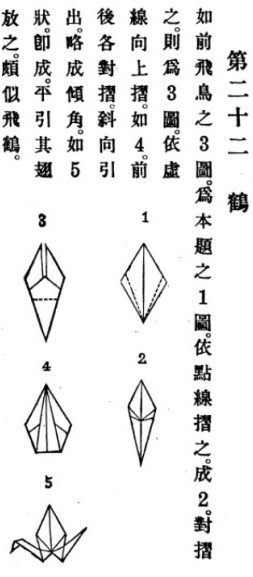

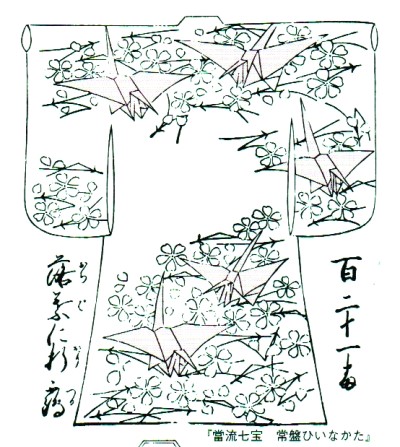
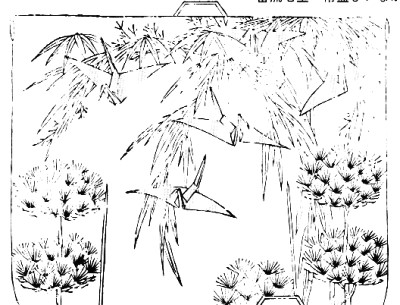
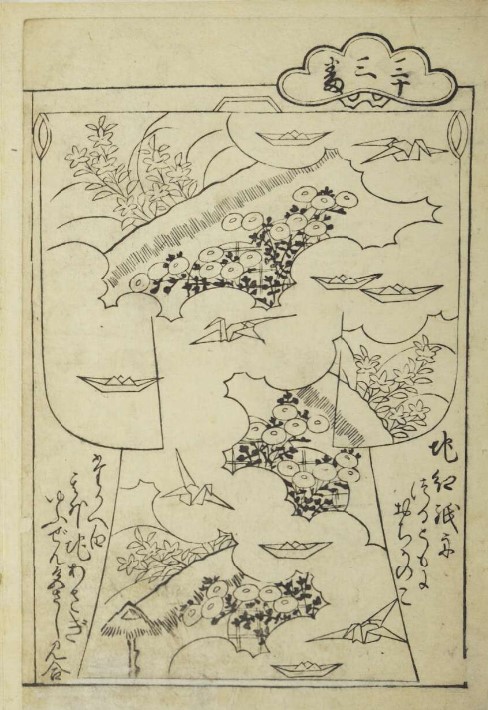
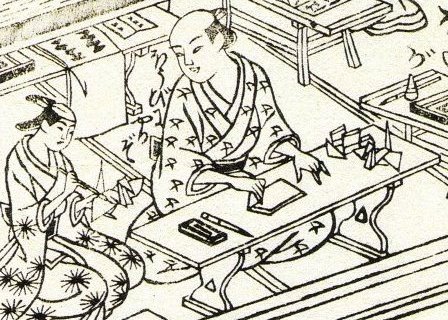








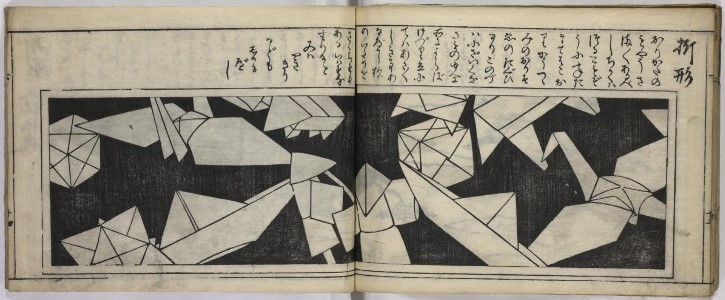

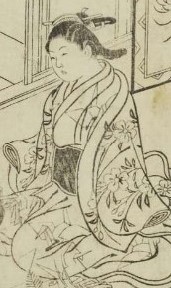



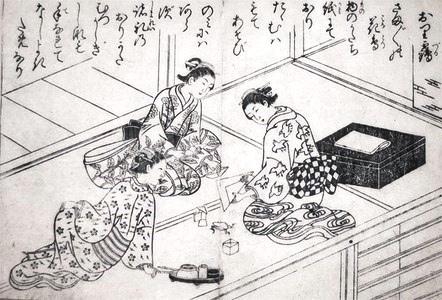
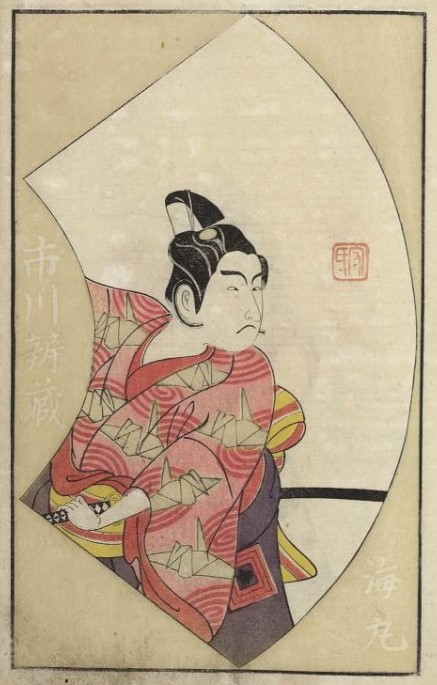
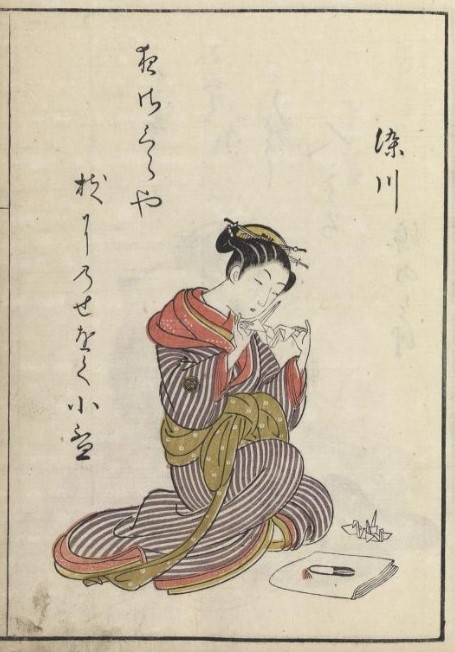
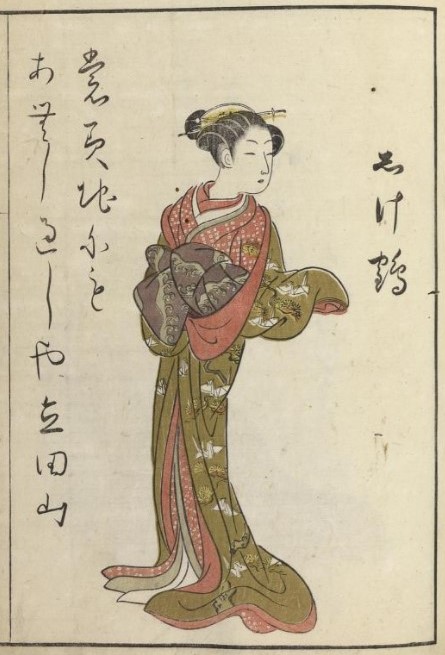
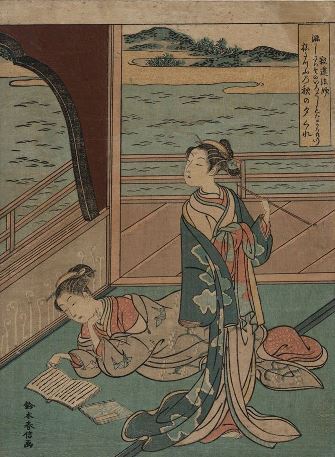
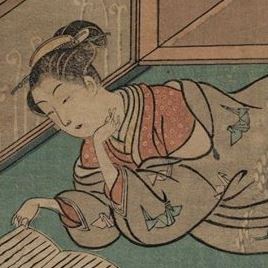
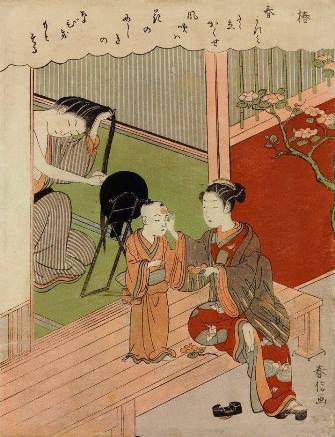
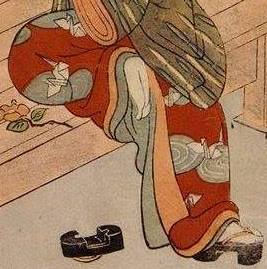
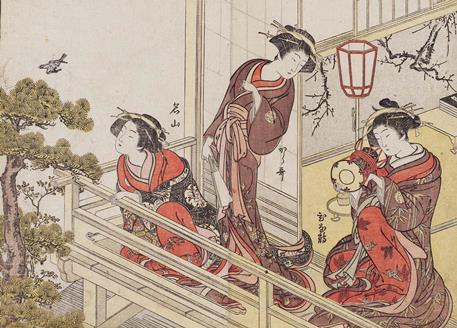
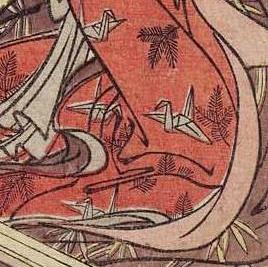
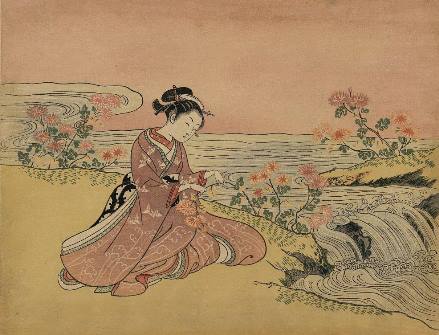
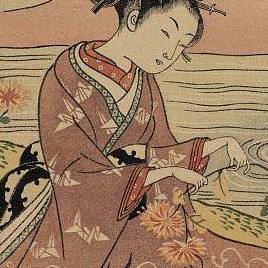
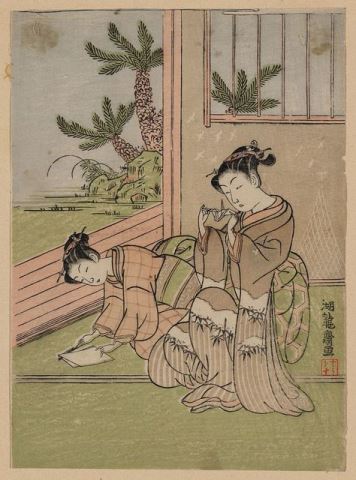
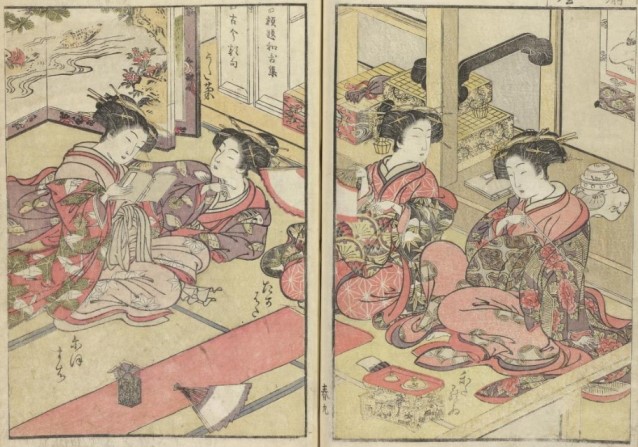
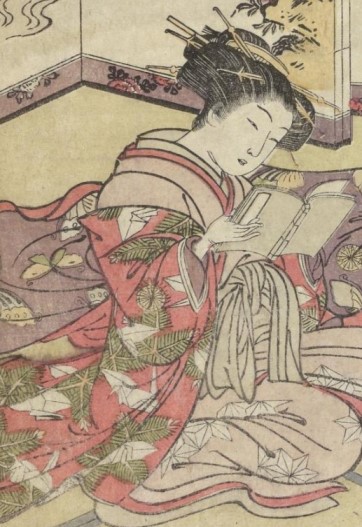
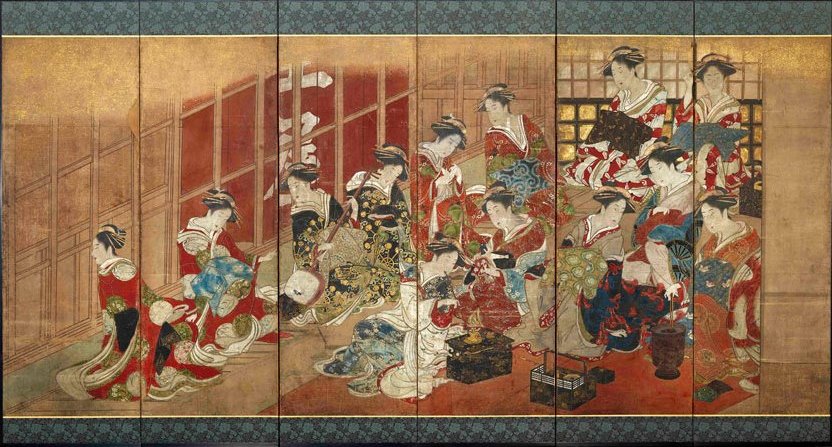
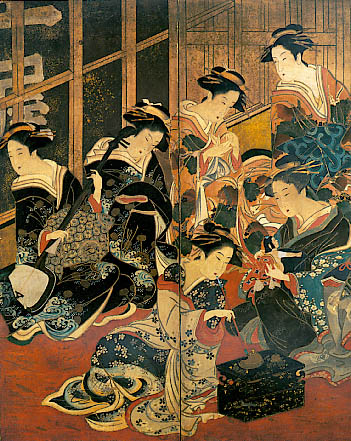
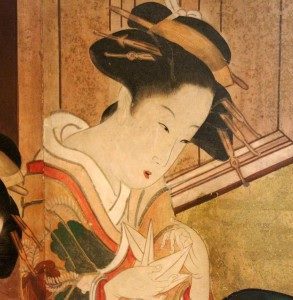
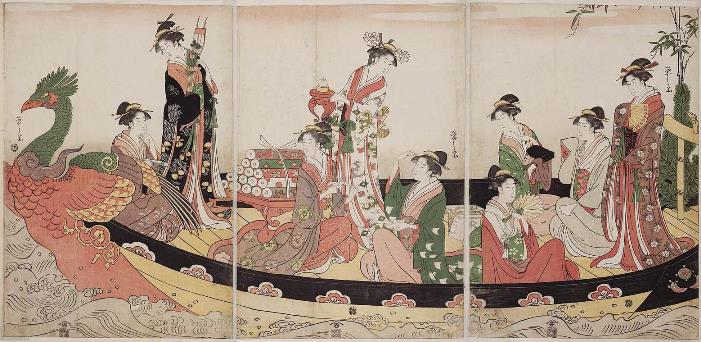
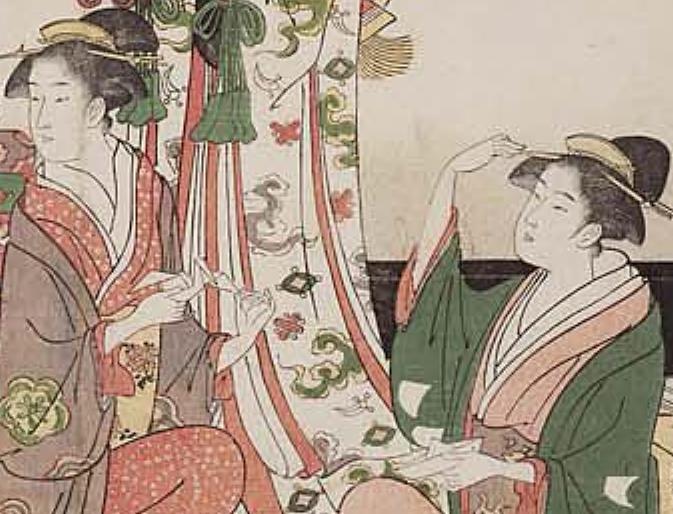
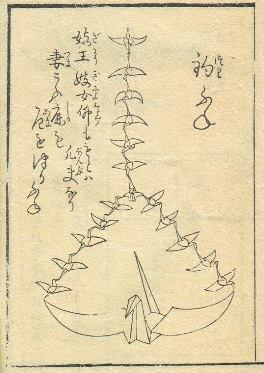
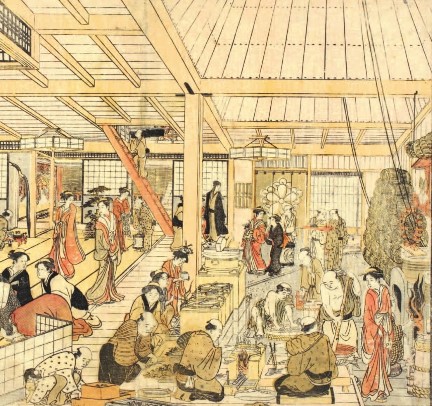

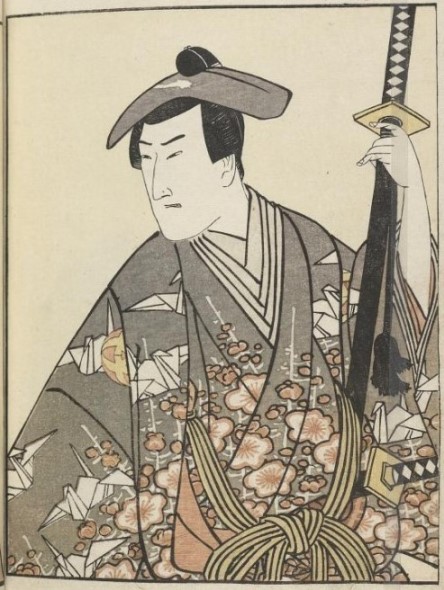
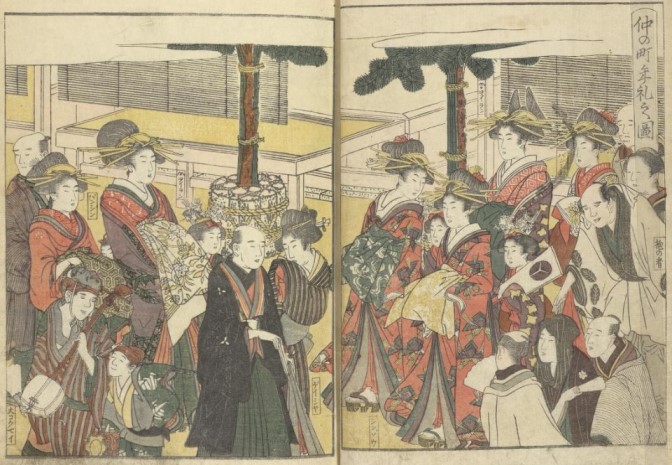
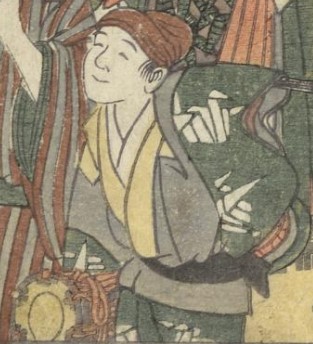
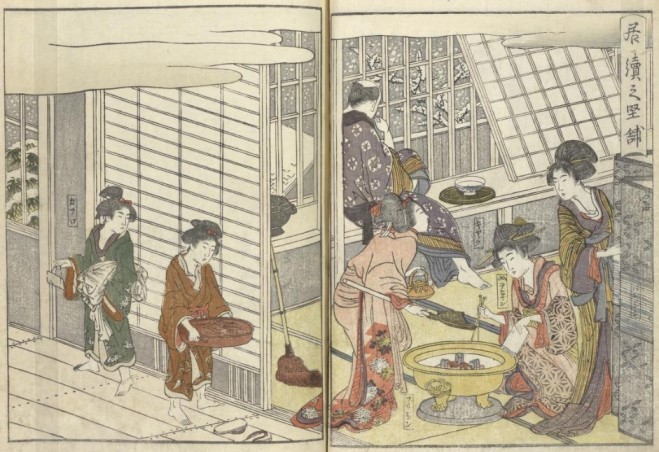
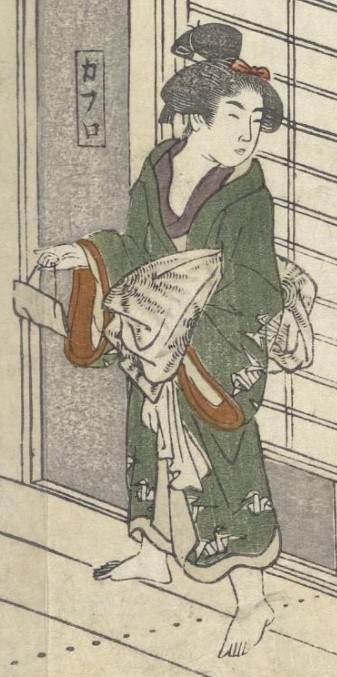
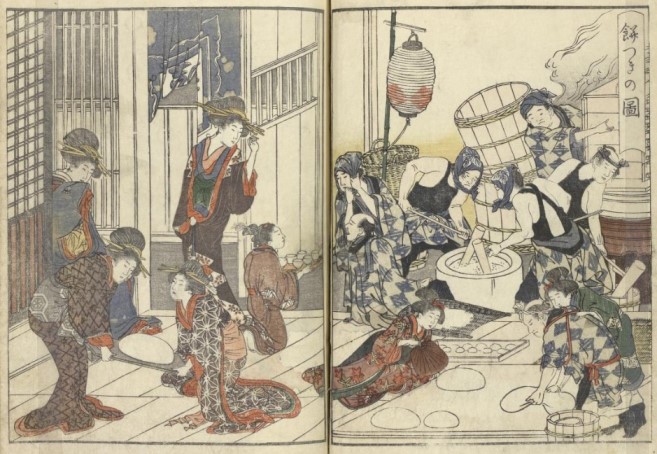
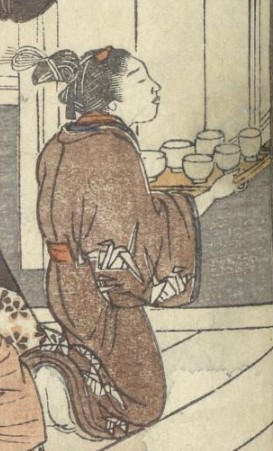
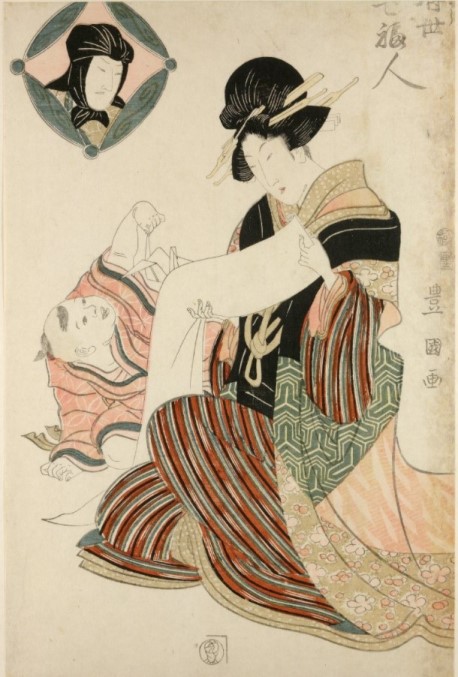
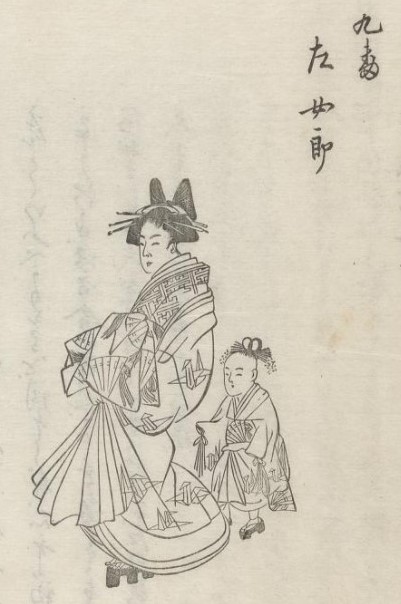
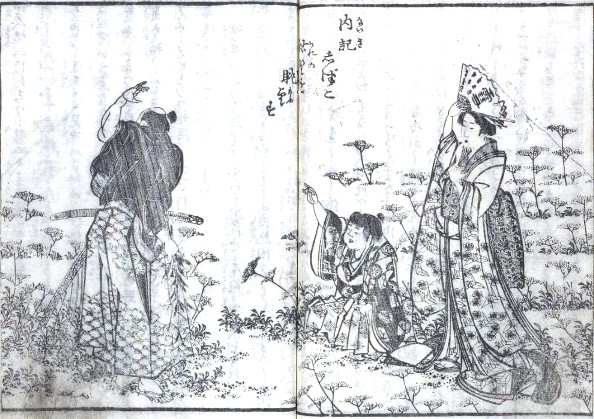
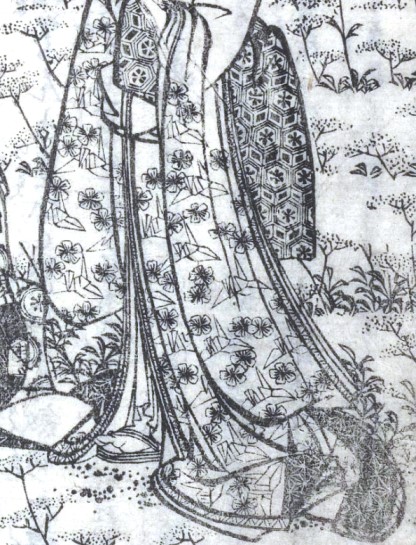
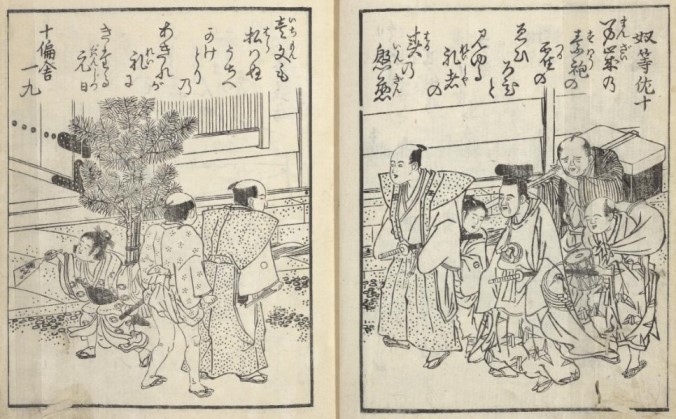
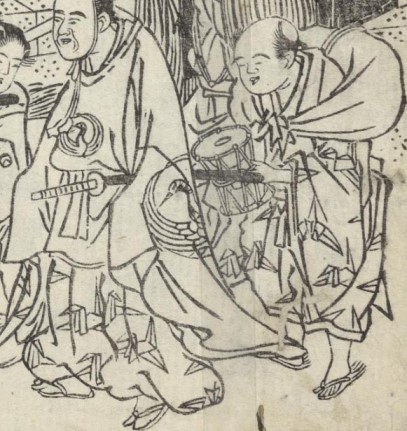
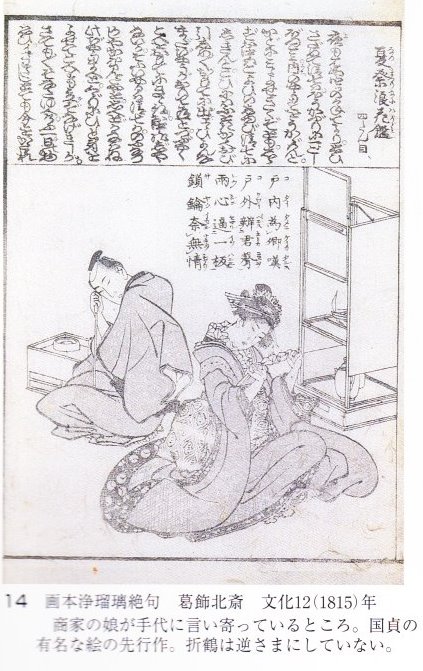
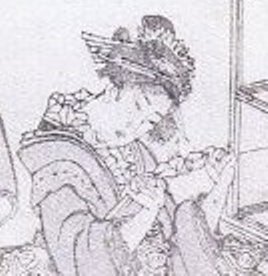
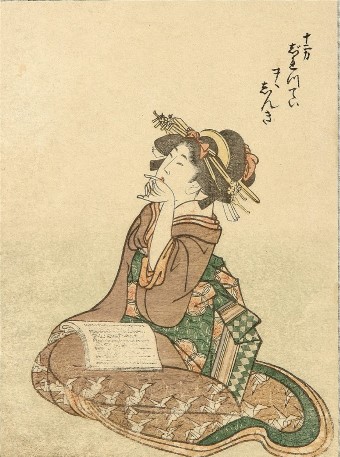
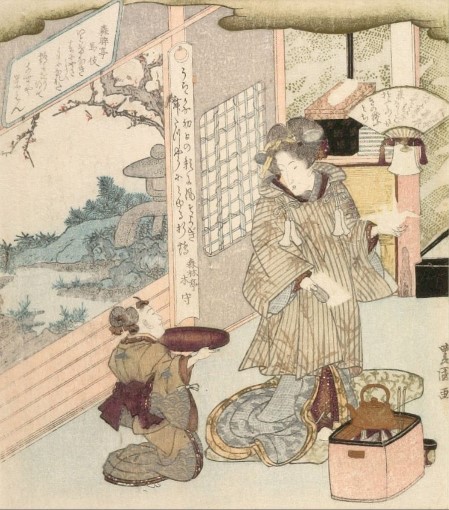
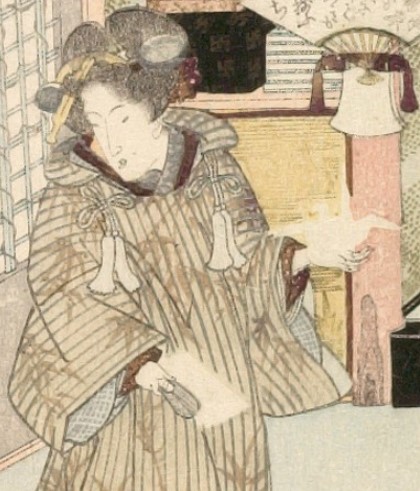
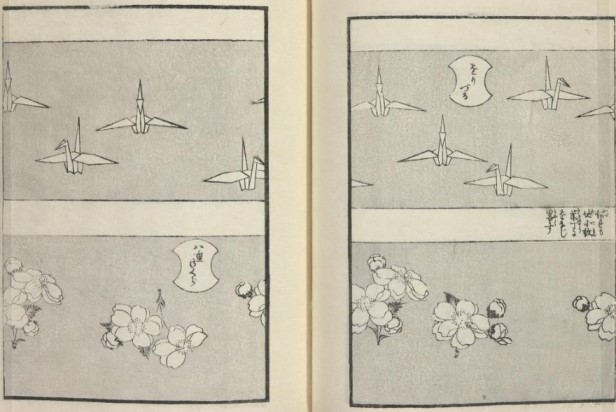
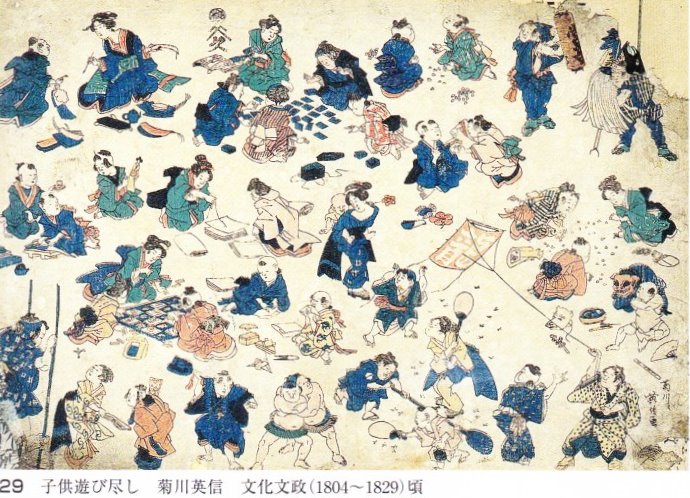
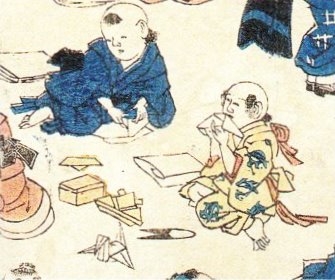
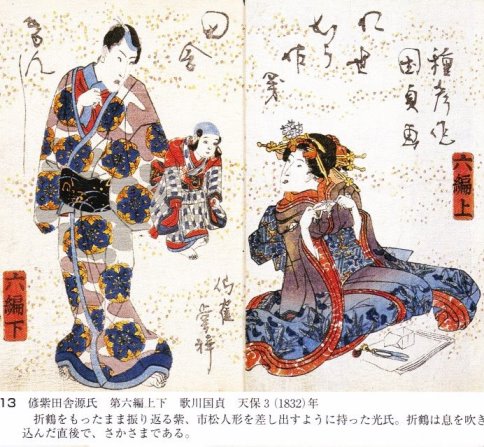
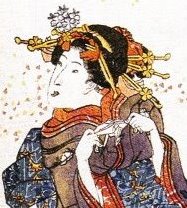
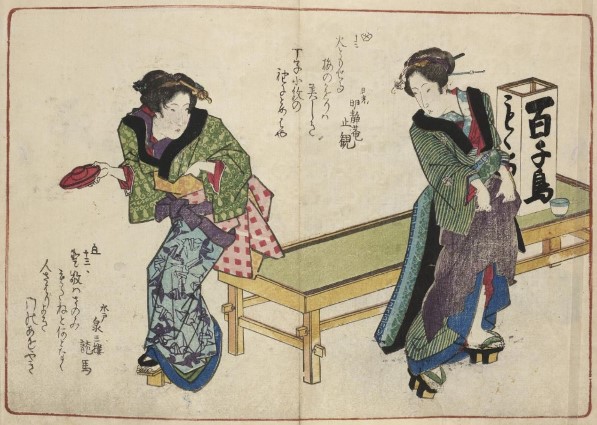
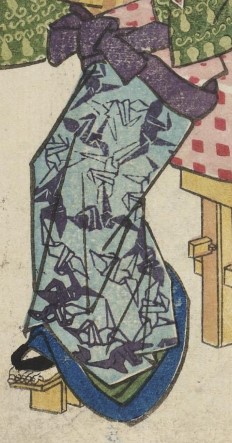
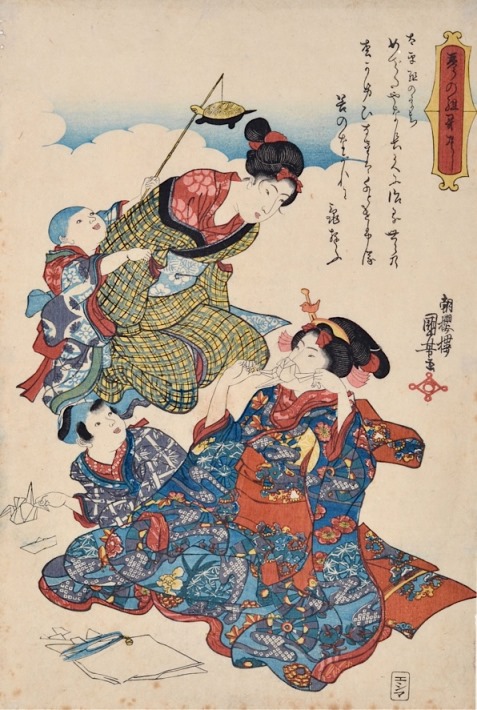
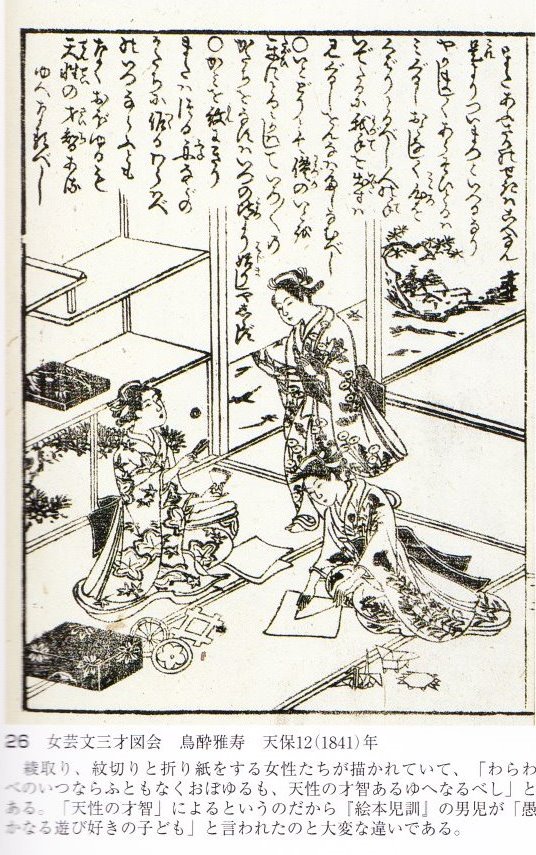
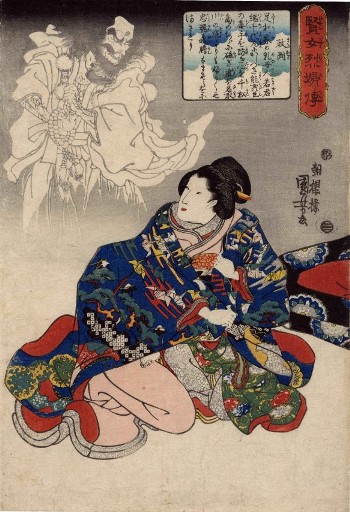
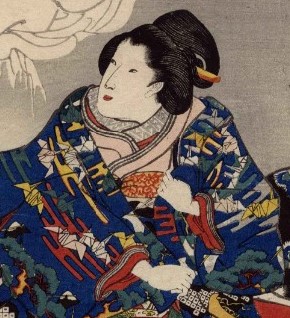
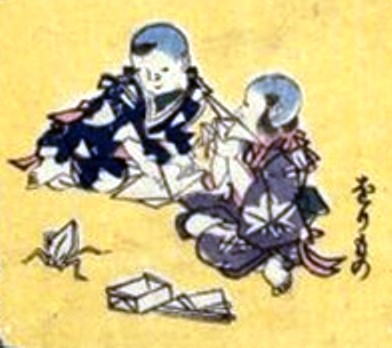
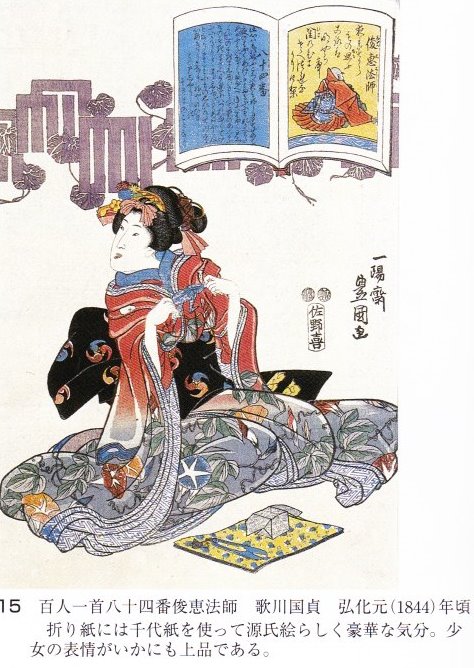
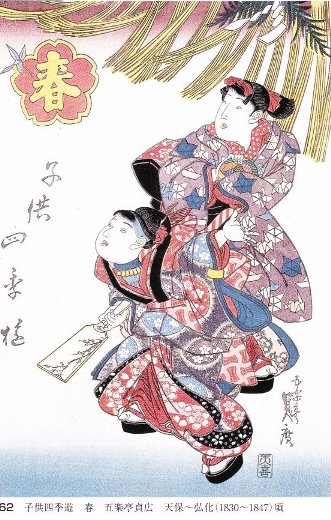
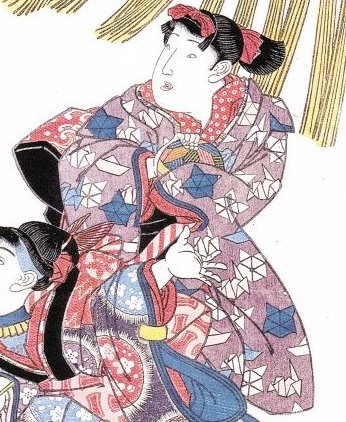
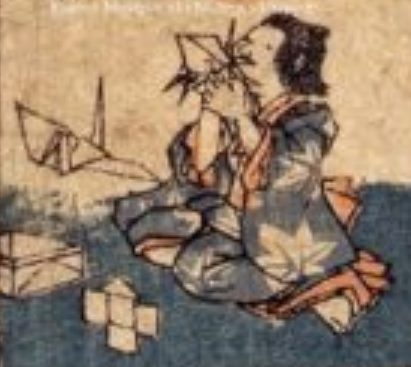
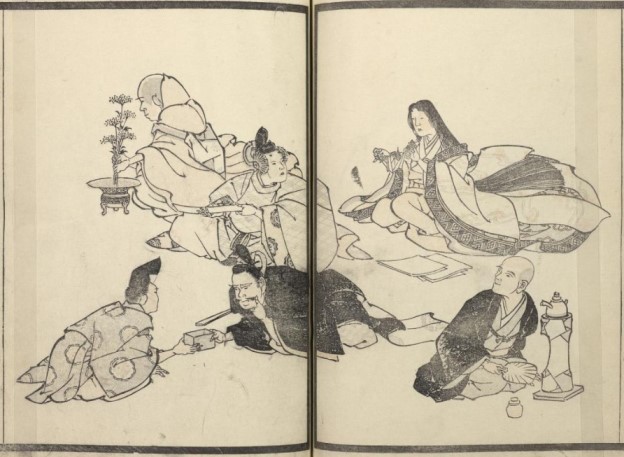
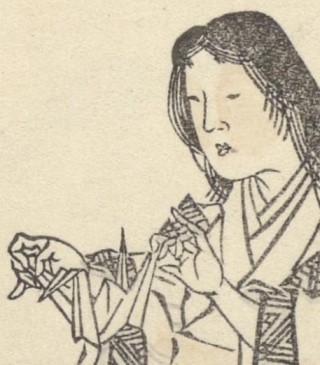
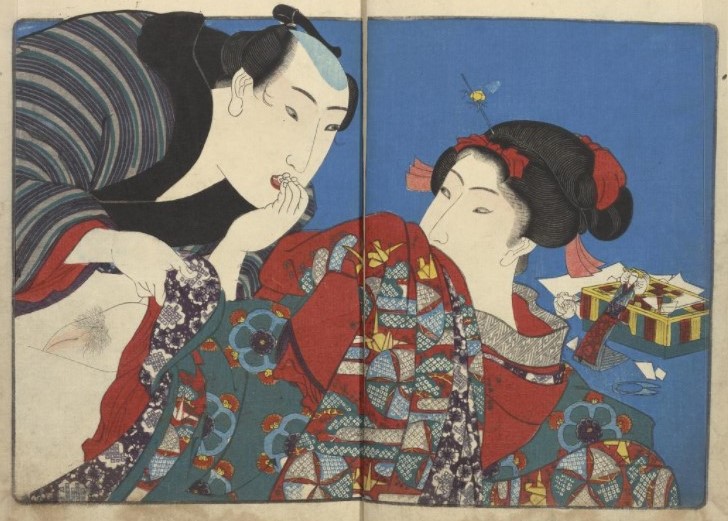
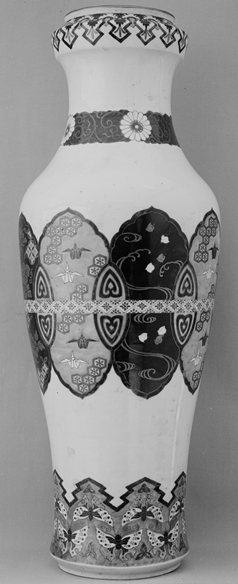
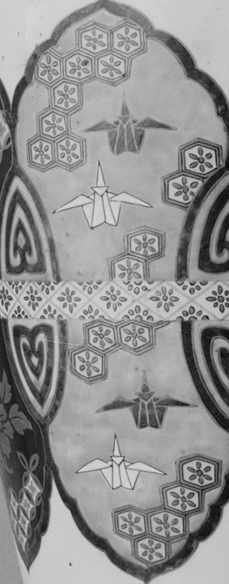
%20Otafuko%20folding%20paper%20cranes.jpg)
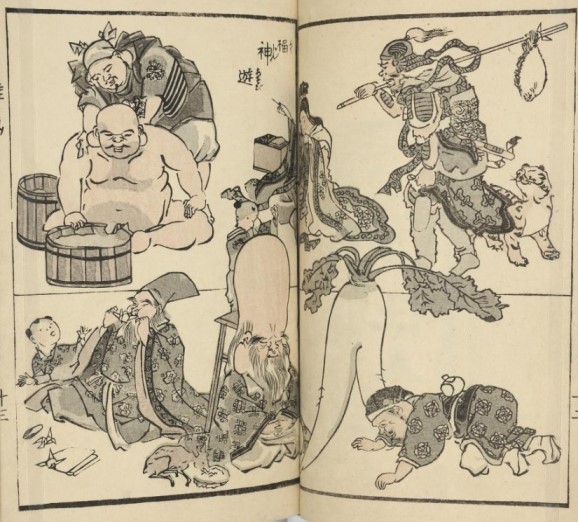
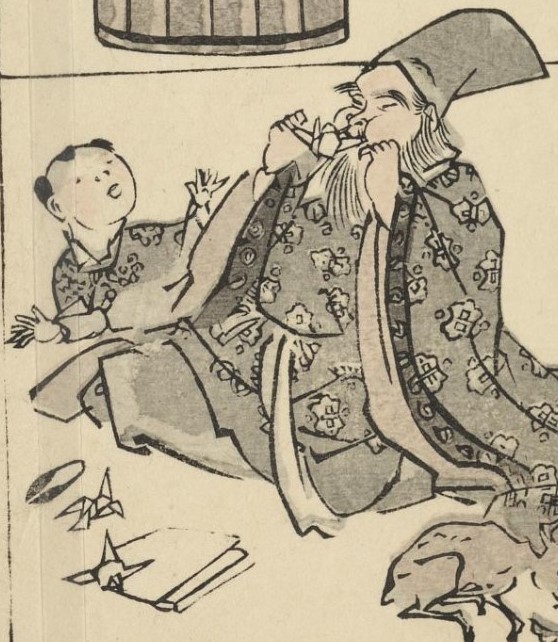
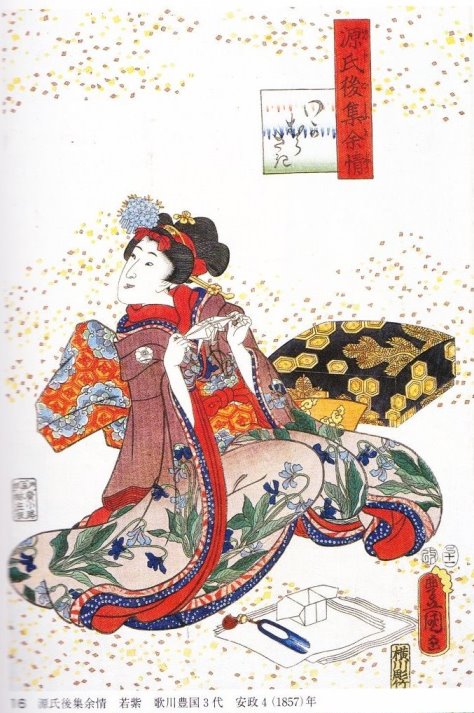
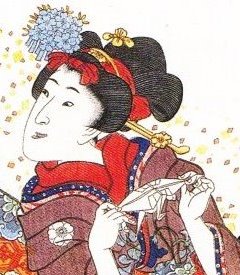
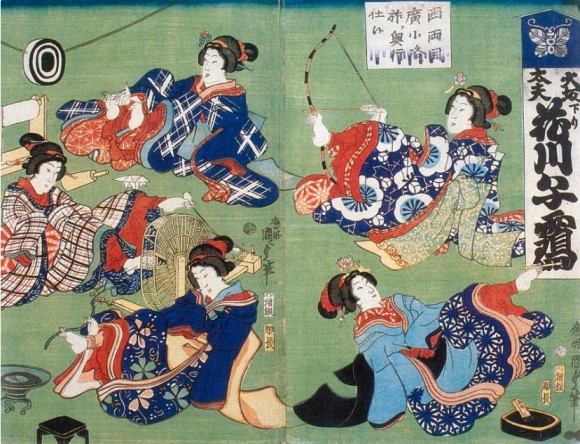
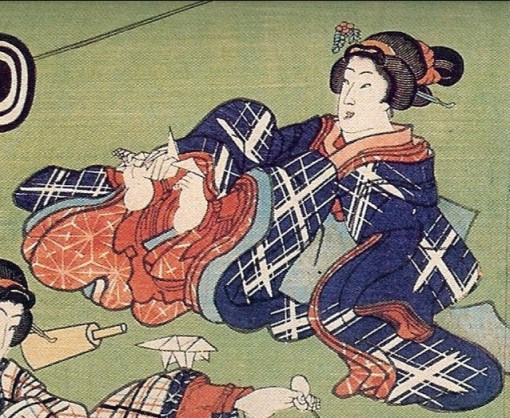
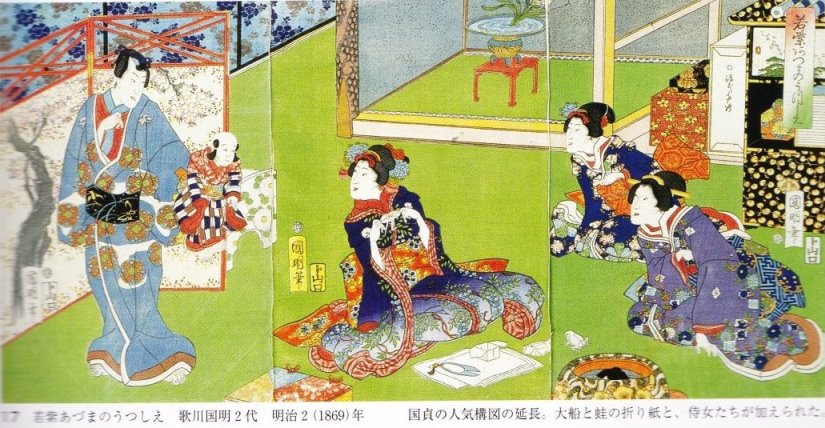
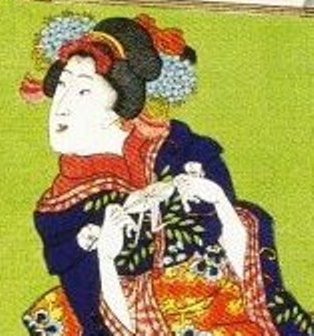

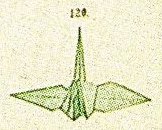
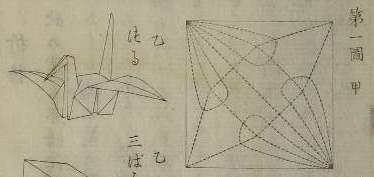
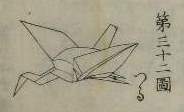
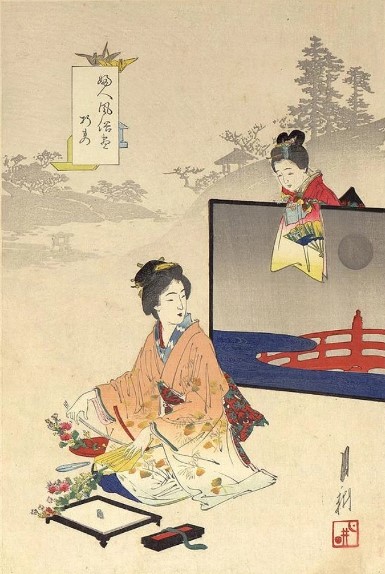
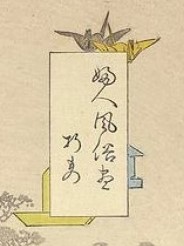
.jpg)
.jpg)
.jpg)
.jpg)
